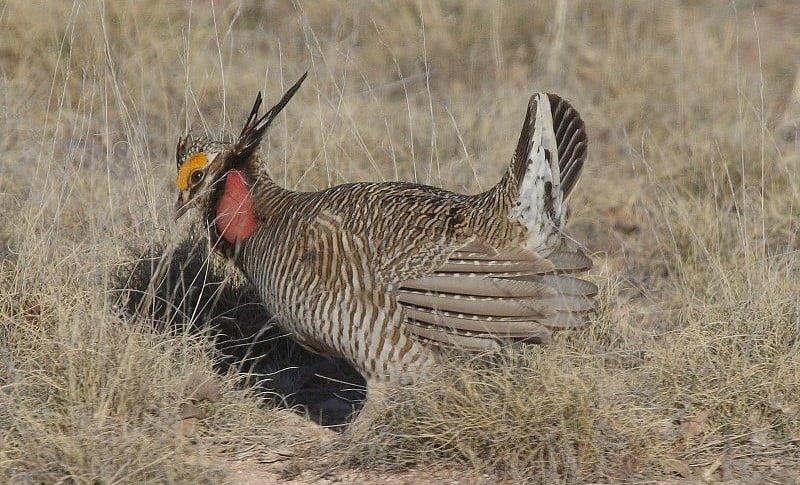
Species
Lesser prairie-chicken (Tympanuchus pallidicinctus)
Principal biologist(s)
Grace Ray, Carter Kruse
Project Locations
Z Bar Ranch, KS
Project Partners
Western Association of Fish & Wildlife Agencies
Conservation Problem
Lesser prairie-chicken populations are threatened by rapid, range-wide decline due to habitat loss and fragmentation.
Conservation Status
- Listed as federally threatened in 2014 but the listing determination was vacated by a federal court in 2015
- The species’ status is currently under review
Project Goals
Our overall goal is to restore ~25,000 acres of the Z Bar mixed grass prairie to a condition suitable for lesser prairie-chickens and to integrate the project into existing bison production and black-tailed prairie dog restoration efforts at the ranch
Objectives
We will increase lesser prairie-chicken numbers at the Z Bar by managing for a diverse landscape mosaic that includes breeding, nesting and brood rearing habitats within close proximity to each other.
Supporting Rationale for Objectives
The Z Bar once supported a modest lesser prairie-chicken population with at least 2 lek sites on the ranch. The population has since decreased, with only occasional sightings of individuals now reported. WAFWA recommends habitat blocks (i.e. lek complexes) of 21,000 – 25,000 acres to support a viable prairie-chicken population. The 42,500-acre Z Bar has sufficient existing and potential habitat to meet that lek complex requirement.
Strategies
• Prescribed fire to improve brood rearing habitat and control woody vegetation with pastures burned at least once every 10 years
• Mechanical removal of woody vegetation from the uplands to limit avian predation and improve suitable lesser prairie-chicken habitat
• Using grazing to produce a mosaic of habitats that include lightly grazed pastures with robust standing vegetation and heavily grazed pastures with minimal standing vegetation
Project Background
The lesser prairie-chicken project at the Z Bar represents one of TESF’s newest conservation efforts on Turner properties. Beginning in early 2015, we began to manage 32,525 acres to benefit lesser prairie-chickens through a cooperative 10-year agreement with WAFWA. Central to the agreement is habitat restoration, which includes the removal of woody vegetation from the uplands on 1,949 acres; prescribed fire in each pasture at least once every ten years; and a prescribed grazing plan intended to help create the vegetative mosaic required by lesser prairie-chickens. By year two of the project, we had satisfied all required habitat restoration and grazing requirements. In March 2016, 41,000 acres of the Z Bar burned in what ended up being the largest wildfire in Kansas history. Ecologically, the Z Bar largely benefited from the fire as it served to refresh native grasses, increase ecosystem heterogeneity, and eliminate invasive woody brush and trees from the uplands, all of which benefit lesser prairie-chickens. Because of this wildfire, no prescribed burns were performed in 2016 or 2017.
Over the course of this project, lesser prairie-chickens have routinely been observed and sightings at the Z Bar appear to be increasing; however, we have yet to verify that lesser prairie-chickens are reproducing on the ranch.
Project Activities in 2018
While lesser prairie-chicken sightings at the Z Bar continue to increase, it is unlikely the ranch supports a breeding population. We are fairly certain of this because the annual lek surveys performed by the TESF, WAFWA, and the TNC over the past five years have not detected any leks on the ranch. Additionally, in 2018 TESF made the additional effort to determine prairie-chicken populations on the Z Bar by establishing and monitoring artificial leks at three sites reported to have been used by prairie-chickens in the past.
Each artificial lek contained six male decoys, a large speaker transmitting a recording from a “booming ground,” and four game cameras arranged to photo capture any chickens attracted to the site. No prairie-chickens were detected on the artificial leks in 2018. Having confirmed with relative certainty the Z Bar does not support a breeding population of lesser prairie-chickens, we will begin the process of critically evaluating habitat and population trends to determine whether conditions support translocating prairie-chickens to the ranch.
Results from WAFWA’s 2018 lesser prairie-chicken habitat surveys indicate the Z Bar continues to make good progress in restoring habitat. For example, in each of the last four years the ranch has surpassed predicted habitat values. In 2018 we continued to improve and expand lesser prairie-chicken habitat by removing trees using a “ball and chain” and prescribed fire.
There remains, however, one habitat component — brood-rearing habitat — which may be population limiting at the ranch. To remedy this shortcoming, we petitioned and received permission from WAFWA to increase bison grazing in 2019 which, in combination with an increase in prescribed fire, should result in an increase in that specific habitat type.
Proposed Future Activities & Considerations
The direction of the lesser prairie-chicken project at the Z Bar hinges on whether we are able to document reproduction and an increase in the population over the coming years. Existing habitat evaluation metrics suggest the habitat requirements for the species have been met at the Z Bar, yet the population remains low. Determining why the population remains low — whether due to vegetative composition, vegetative community structure and arrangement, distance from source populations, or a combination of the aforementioned factors, or others — will be examined.
